If 2015 has offered a crop of lovely picture books for readers to peruse, clearly it also has offered readers several fascinating chapter books and nonfiction titles. Bibliophiles who enjoy literature for children and young adults will find several must-haves from the wide array of titles available from publishers this year. The titles listed here represent only a sample of the favorites.
Ages 8–13
Finding Serendipity. Angelica Banks. Ill. Stevie Lewis. 2015. Henry Holt.
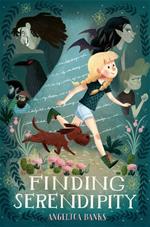 Writers find inspiration in all sorts of ways. As her mother finishes another manuscript concluding her wildly popular series, Tuesday McGillycuddy is drawn unexpectedly into her mother’s mysterious world. As she searches for her mother, Tuesday encounters several interesting individuals, including Vivienne Small, the swashbuckling heroine of her mother’s books, as well as pirates and a notorious bad guy who practically springs back from the dead. This charming story has much to recommend it, including its characters and the protagonist’s loyal dog Baxterr. Although others have written about worlds where creativity lives, this one is incredibly detailed and imaginative, deftly blurring the line between reality and fantasy and revealing that imagination has much to do with both. Amusingly, Tuesday’s mother plays a role when she must deal with fans, appearing much larger than life and donning disguises in order to thwart her fans and ensure some private time. The book was published originally in Australia.
Writers find inspiration in all sorts of ways. As her mother finishes another manuscript concluding her wildly popular series, Tuesday McGillycuddy is drawn unexpectedly into her mother’s mysterious world. As she searches for her mother, Tuesday encounters several interesting individuals, including Vivienne Small, the swashbuckling heroine of her mother’s books, as well as pirates and a notorious bad guy who practically springs back from the dead. This charming story has much to recommend it, including its characters and the protagonist’s loyal dog Baxterr. Although others have written about worlds where creativity lives, this one is incredibly detailed and imaginative, deftly blurring the line between reality and fantasy and revealing that imagination has much to do with both. Amusingly, Tuesday’s mother plays a role when she must deal with fans, appearing much larger than life and donning disguises in order to thwart her fans and ensure some private time. The book was published originally in Australia.
Moon Bear. Gill Lewis. Ill. Alessandro Gottardo. 2015. Atheneum Books for Young Readers.
 Twelve-year-old Tam and his best friend Noy find a moon bear cub in Laos but fail to capture it, losing much-needed cash for their families. After their village is relocated to make way for a road and a dam, Tam travels to the city to work in a bear bile farm. The tender-hearted and kind boy is horrified at the bears’ treatment. When the bear cub he first saw in the mountains turns up in a severely malnourished condition, he vows to save the bear Sook-dii from a similar fate. But the same general who moved the villagers away from their mountain homes and had Tam brought to the city has a daughter who is very ill. Desperate to save her, he is convinced that bile milked from moon bears might provide a cure. Poor Sook-dii becomes lethargic and ill under this mistreatment as bile is harvested from his body. This book from Great Britain leaves readers with a lot about which to think and is recommended highly as readers will ponder the lengths some humans will go to find a supposed cure.
Twelve-year-old Tam and his best friend Noy find a moon bear cub in Laos but fail to capture it, losing much-needed cash for their families. After their village is relocated to make way for a road and a dam, Tam travels to the city to work in a bear bile farm. The tender-hearted and kind boy is horrified at the bears’ treatment. When the bear cub he first saw in the mountains turns up in a severely malnourished condition, he vows to save the bear Sook-dii from a similar fate. But the same general who moved the villagers away from their mountain homes and had Tam brought to the city has a daughter who is very ill. Desperate to save her, he is convinced that bile milked from moon bears might provide a cure. Poor Sook-dii becomes lethargic and ill under this mistreatment as bile is harvested from his body. This book from Great Britain leaves readers with a lot about which to think and is recommended highly as readers will ponder the lengths some humans will go to find a supposed cure.
Spidermania: Friends on the Web. Alexandra Siy. Photos by Dennis Kunkel. 2015. Holiday House.
 In the same fashion with which this creative team explored mosquitoes in Mosquito Bite (2006) and bugs in Bug Shots (2011), they’re at it again, relying on facts to eradicate negative attitudes about spiders. Using a high-power scanning electron microscope to provide image of spiders and their various body parts as well as well-written, lively text that makes them even more fascinating than readers might think, the book highlights 10 different types of spiders, including the diving bell spider, the wolf spider, the crab spider, and the spitting spider. Designed to remind readers that spiders aid humans, the book enables readers to see how those amazingly intricate webs they produce are formed. Even someone who knows a lot about spiders will learn a thing or two from this entrancing book, brimming with stunning photography and a respectful attitude toward spiders. There is even a section on eye patterns and how to identify various spiders, making this title useful for many science classrooms.
In the same fashion with which this creative team explored mosquitoes in Mosquito Bite (2006) and bugs in Bug Shots (2011), they’re at it again, relying on facts to eradicate negative attitudes about spiders. Using a high-power scanning electron microscope to provide image of spiders and their various body parts as well as well-written, lively text that makes them even more fascinating than readers might think, the book highlights 10 different types of spiders, including the diving bell spider, the wolf spider, the crab spider, and the spitting spider. Designed to remind readers that spiders aid humans, the book enables readers to see how those amazingly intricate webs they produce are formed. Even someone who knows a lot about spiders will learn a thing or two from this entrancing book, brimming with stunning photography and a respectful attitude toward spiders. There is even a section on eye patterns and how to identify various spiders, making this title useful for many science classrooms.
Sunny Side Up. Jennifer L. Holm. Ill. Matthew Holm. Graphix.
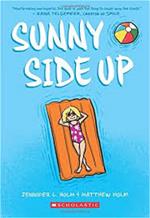 Ten-year-old Sunny has been sent south from Pennsylvania to spend the summer with her grandfather in a retirement village in Florida in 1976. The days are routine with small errands being their highlight, and Sunny spends her nights trying to get comfortable on the squeaky sofa sleeper. Sunny happens to meet Buzz, the son of the groundskeeper, who introduces her to comics. These stories of superheroes provide blissful hours of escape. The two earn spending money for their reading material by finding lost cats for the residents. But readers will slowly realize that there’s a reason Sunny has been packed off to Florida. As the truth is revealed about her beloved older brother Dale and his problems with substance abuse, Sunny’s confusion about his actions is clear. Although she loves her brother and has even covered up for him at times, she is also confused, scared, sad, and embarrassed by some of his antics. Her feelings even spill over into her present situation as she finds cigarettes secreted in the most unlikely places and realizes that her grandfather is lying about his smoking. An excellent starting place to discuss addiction and family secrets, this graphic novel may reassure some readers while showing the far-reaching effects of addiction.
Ten-year-old Sunny has been sent south from Pennsylvania to spend the summer with her grandfather in a retirement village in Florida in 1976. The days are routine with small errands being their highlight, and Sunny spends her nights trying to get comfortable on the squeaky sofa sleeper. Sunny happens to meet Buzz, the son of the groundskeeper, who introduces her to comics. These stories of superheroes provide blissful hours of escape. The two earn spending money for their reading material by finding lost cats for the residents. But readers will slowly realize that there’s a reason Sunny has been packed off to Florida. As the truth is revealed about her beloved older brother Dale and his problems with substance abuse, Sunny’s confusion about his actions is clear. Although she loves her brother and has even covered up for him at times, she is also confused, scared, sad, and embarrassed by some of his antics. Her feelings even spill over into her present situation as she finds cigarettes secreted in the most unlikely places and realizes that her grandfather is lying about his smoking. An excellent starting place to discuss addiction and family secrets, this graphic novel may reassure some readers while showing the far-reaching effects of addiction.
The Tortoise and the Soldier: A Story of Courage and Friendship in World War I. Michael Foreman. 2015. Henry Holt.
Young Henry Friston dreams of seeing the world and often stares at the world map in his classroom rather than paying attention in class. After a brief stint as a deckhand, he joins the Royal Navy and becomes a gunner in World War I. He faces much danger, eventually engaging in trench warfare in Gallipoli where he and a tortoise end up together in a safe spot. As the violence rages around them, Henry shares a tomato with him and tells stories about home. After the shelling has ceased and Henry is reunited with his crew, he decides impulsively to take the tortoise with him. He and Ali Pasha become inseparable, and he somehow manages to keep his presence a secret from most of the men. Once they return to England, the tortoise settles into an idyllic life. The fact that this account is based on a true story adds to its charms, even while the framing of the story through the eyes of a boy intent on getting his first feature published in the local newspaper works well. This heart-tugging book from the United Kingdom stands as an example of heroism and the comfort that can be found from even the smallest creatures during wartime.
Ages 14+
Chasing Secrets. Gennifer Choldenko. 2015. Wendy Lamb.
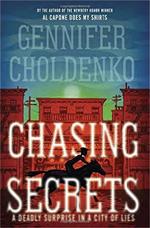 Even while 13-year-old Lizzie Kennedy dreams of following in her father’s footsteps and becoming a doctor, her older brother is disinterested in that career, which causes conflict between the boy and his father. Lizzie hates the school she must attend because the studies seem pointless and the other girls seem to tease her or avoid her. But when the family’s Chinese cook, Jing, is unable to come home because of a quarantine related to a suspected plague in China Town, she stumbles on his secret. As a friendship between Noah, Jing’s son, and Lizzie develops, she also finds friendship with Gemma, a classmate, and her brother, Gus. While Lizzie endeavors to get Jing out of Chinatown and back home, she learns about the racism and injustice that lie beneath the city’s superficial politeness, even among those who make a living by taking care of others. Lizzie is irresistible, even as she battles with her Aunt Hortense and the social norms of her times. Perfect for sharing aloud, this is a well-written, totally engaging title, filled with action, intrigue, and bits of humor provided in part by Lizzie’s efforts to send messages to Noah via a most reluctant feline messenger.
Even while 13-year-old Lizzie Kennedy dreams of following in her father’s footsteps and becoming a doctor, her older brother is disinterested in that career, which causes conflict between the boy and his father. Lizzie hates the school she must attend because the studies seem pointless and the other girls seem to tease her or avoid her. But when the family’s Chinese cook, Jing, is unable to come home because of a quarantine related to a suspected plague in China Town, she stumbles on his secret. As a friendship between Noah, Jing’s son, and Lizzie develops, she also finds friendship with Gemma, a classmate, and her brother, Gus. While Lizzie endeavors to get Jing out of Chinatown and back home, she learns about the racism and injustice that lie beneath the city’s superficial politeness, even among those who make a living by taking care of others. Lizzie is irresistible, even as she battles with her Aunt Hortense and the social norms of her times. Perfect for sharing aloud, this is a well-written, totally engaging title, filled with action, intrigue, and bits of humor provided in part by Lizzie’s efforts to send messages to Noah via a most reluctant feline messenger.
Drowned City: Hurricane Katrina and New Orleans. Don Brown. 2015. Houghton Mifflin Harcourt Books for Young Readers.
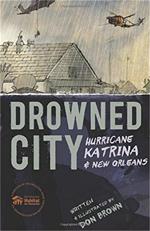 This outstanding graphic novel depiction of the events surrounding Hurricane Katrina focuses on New Orleans, much of which was under water after August 29, 2005. Relying on illustrations created with pen and ink and digital paint, Brown’s illustrations have somehow managed to thrust readers into the hectic events surrounding this natural disaster. Beginning appropriately enough as the hurricane grows in strength during the late days of August, the story concludes as New Orleans continues to recover, now protected by expansive walls that rise 26 feet. In between, the book features many elements that received much attention in the media as well as other, more private tragedies. It’s all here: The city’s citizens left behind when avenues of escape are denied. The family pets torn from the arms of their human companions. The Louisiana Department of Wildlife and Fisheries and the Coast Guard’s heroic rescues of thousands of individuals. The long lines outside the Superdome and the Convention Center. A governor and a President seemingly at cross purposes and a mayor who seems to have disappeared. Told in an engaging fashion that will leave readers breathless from its pace, this account of a disaster that can be laid at the foot of humans as much as Mother Nature, reminding readers of mistakes that must never be repeated. This book deservedly was tapped for the 2016 NCTE Orbis Pictus Award for Outstanding Nonfiction for Children.
This outstanding graphic novel depiction of the events surrounding Hurricane Katrina focuses on New Orleans, much of which was under water after August 29, 2005. Relying on illustrations created with pen and ink and digital paint, Brown’s illustrations have somehow managed to thrust readers into the hectic events surrounding this natural disaster. Beginning appropriately enough as the hurricane grows in strength during the late days of August, the story concludes as New Orleans continues to recover, now protected by expansive walls that rise 26 feet. In between, the book features many elements that received much attention in the media as well as other, more private tragedies. It’s all here: The city’s citizens left behind when avenues of escape are denied. The family pets torn from the arms of their human companions. The Louisiana Department of Wildlife and Fisheries and the Coast Guard’s heroic rescues of thousands of individuals. The long lines outside the Superdome and the Convention Center. A governor and a President seemingly at cross purposes and a mayor who seems to have disappeared. Told in an engaging fashion that will leave readers breathless from its pace, this account of a disaster that can be laid at the foot of humans as much as Mother Nature, reminding readers of mistakes that must never be repeated. This book deservedly was tapped for the 2016 NCTE Orbis Pictus Award for Outstanding Nonfiction for Children.
Honor Girl: A Graphic Memoir. Maggie Thrash. 2015. Candlewick.
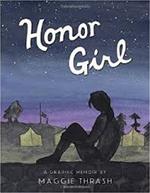 Fifteen-year-old Maggie Thrash once again spends her summer at a camp in Kentucky, where she falls in love for the very first time. To her surprise, the object of her affections is Erin, an older camp counselor. Although Erin seems to return her affections, the two only go so far as holding hands and spending time together. Despite their secrecy, the usual rumors fly and the girls are separated. Woven into this heartbreaking story of prejudice and missed opportunities is the Maggie’s own struggle to find herself. After Maggie is named honor girl, an annual camp distinction, the distinction is tainted by her realization that perhaps she is being rewarded for remaining silent, following the rules without question, and being a good girl rather than being honest. This graphic novel gently explores one girl’s first giddy feelings of affection toward another human being and the uncertainty about the path that lies ahead. Readers may recognize themselves in Maggie’s halting steps toward adulthood and self-awareness even while noting that some of those who should have been older, wiser, and saner show their prejudices in ugly ways. Ultimately, it’s clear that being Honor Girl isn’t particularly honorable, especially when the cost of that distinction is considered.
Fifteen-year-old Maggie Thrash once again spends her summer at a camp in Kentucky, where she falls in love for the very first time. To her surprise, the object of her affections is Erin, an older camp counselor. Although Erin seems to return her affections, the two only go so far as holding hands and spending time together. Despite their secrecy, the usual rumors fly and the girls are separated. Woven into this heartbreaking story of prejudice and missed opportunities is the Maggie’s own struggle to find herself. After Maggie is named honor girl, an annual camp distinction, the distinction is tainted by her realization that perhaps she is being rewarded for remaining silent, following the rules without question, and being a good girl rather than being honest. This graphic novel gently explores one girl’s first giddy feelings of affection toward another human being and the uncertainty about the path that lies ahead. Readers may recognize themselves in Maggie’s halting steps toward adulthood and self-awareness even while noting that some of those who should have been older, wiser, and saner show their prejudices in ugly ways. Ultimately, it’s clear that being Honor Girl isn’t particularly honorable, especially when the cost of that distinction is considered.
Young Man With Camera. Emil Sher. 2015. Photos by David Wyman. Scholastic.
 T— is the subject of severe bullying from a group of classmates led by Ryan, a young man whose anger and violence are hidden beneath a veneer that belies his cruel interior. T— finds solace in photography and his friendship with Sean and a homeless woman named Lucy, whose wry cardboard statements provide amusing social commentary. Ryan’s harassment of T— intensifies, especially when he realizes that T— has seen something that could land Ryan in hot water, and when his threats seem to have little effect on the boy, he threatens others who are important to him. The book contains black-and-white photos taken by the protagonist, all of which provide insight into the wonders of the world around him. With support from Ms. Karamath, a teacher at his school, and inspiration from Diane Arbus, whose work celebrated marginalized individuals, T— finds the courage to let his images speak for him to right the wrongs he sees around him.
T— is the subject of severe bullying from a group of classmates led by Ryan, a young man whose anger and violence are hidden beneath a veneer that belies his cruel interior. T— finds solace in photography and his friendship with Sean and a homeless woman named Lucy, whose wry cardboard statements provide amusing social commentary. Ryan’s harassment of T— intensifies, especially when he realizes that T— has seen something that could land Ryan in hot water, and when his threats seem to have little effect on the boy, he threatens others who are important to him. The book contains black-and-white photos taken by the protagonist, all of which provide insight into the wonders of the world around him. With support from Ms. Karamath, a teacher at his school, and inspiration from Diane Arbus, whose work celebrated marginalized individuals, T— finds the courage to let his images speak for him to right the wrongs he sees around him.
Barbara A. Ward teaches graduate and undergraduate courses in literacy at Washington State University, Pullman. She spent 25 years teaching in the public schools of New Orleans, where she worked with students at every grade level, from kindergarten through high school as well as several ability levels. She is certified in elementary education, English education, and gifted education. She holds a bachelor's in communications and a master's in English Education from the University of Tennessee and a PhD in Curriculum and Instruction from the University of New Orleans.
These reviews are submitted by members of the International Reading Association's Children's Literature and Reading Special Interest Group (CL/R SIG) and are published weekly on Literacy Daily.